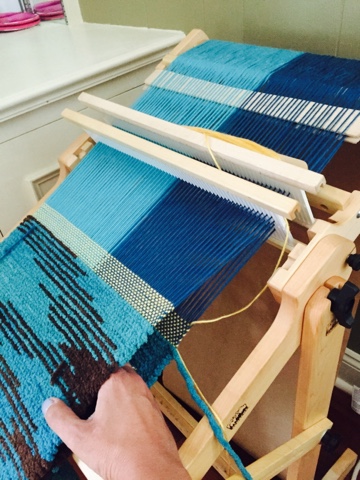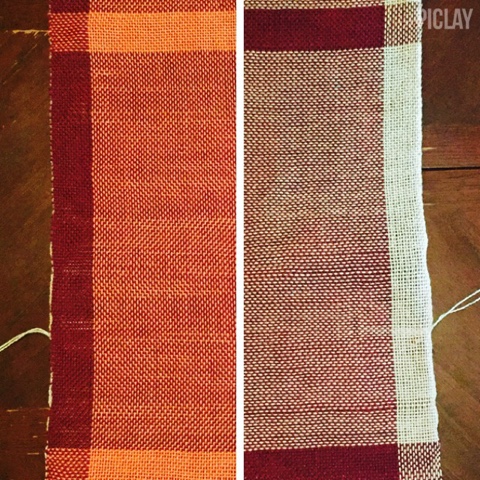The possibilities are endless for your rigid heddle loom when you learn how use two heddles. The problem is that threading two heddles is much more time consuming than one. Project planning is essential. For me, it seems silly to tie on a short warp and then meticulously sley all those threads for a small project. I will show you how you can maximize your warp, and all the work that went into threading, to produce two vastly different pieces of fabric off of one long warp.
You will need:
3/2 Pearl Cotton for the warp & weft
Any bully or super bulk yarn for weft
15" or larger rigid heddle loom w/ two heddle capacity
2 8 dent heddles
2 pickup sticks
The 1st project is a doubleweave rug. I threaded the two heddles with cream colored 3/2 Pearl cotton.
Weave about 1 inch of plain weave.
Time for pickup sticks.
2. Both heddles up. Slide stick 1 to the rear of the heddles. Insert pickup stick 2 in the lower shed that forms. Slide both pickup sticks to the back of the loom.
Begin the double width pattern with your header yarn. Weave about an inch. By weaving a header in pattern, it will be easier to finish your rug/mat when it's off the loom. You can't hem stitch double width cloth on the loom so the header will assist you in hem stitching after the fabric is finished or when it comes to machine stitching; whichever you choose.
You can see from the header how it is possible to weave two completely different setts with the same warp, weft and threading. The 1st part of the header is 16 epi, while the doubleweave section is 8 epi.
Double Width Pattern
1. Pickup stick 1
2. Heddle 2 up
3. Pickup stick 2
4. Heddle 1 down
You can use any color pattern you want. Based on the amounts of yarn I had, I alternated large areas of each color separated by thin stripes of black and the other colors. It really doesn't matter. At the beginning of your weaving you should add a guide string. I measure a piece of yarn the length I want my weaving to be and pin it on.
End with your waste yarn in pattern for 1 inch then in plain weave for one inch.
Now for the second project, a placemat.
I wove a header in fingering weight yarn in a cream color. Then, using a blue 3/2 cotton weft, wove about 1 inch of a lace pattern:
1. Heddle 1 up
2. Heddle 1 down
3. Heddle 2 up
I wove another inch in plain weave with the cream header yarn.
I then alternated one pick of the cream yarn with one pick of the blue.
Depending on how much warp you have left, you can weave a placemat or a table runner. When you have reached your desired length, reverse the directions above and you're done.
Now, it's on to the sewing machine and then the washer & dryer. Keep checking back for pictures of the finished products. Happy Weaving!




































